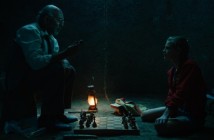Cast: Kim Ki-duk
Director: Kim Ki-duk
Country: South Korea
Genre: Documentary | Drama
Official Trailer: Here
This article is the third part in Rowena’s three part series on Contemporary Korean Cinema entitled ‘Kim Ki-duk and the Cinema of Embodied Unpleasures‘.
In 2011, Kim Ki-duk returned to the world of film after a two-year hiatus by putting two new films on the international film festival circuit: his first ever documentary film Arirang and his seventeenth film Amen. Over and above the context of the hiatus, Arirang is a watershed moment in Kim’s filmography. Not only does Arirang continue the principal themes and elements of his narrative features and arguably constitute a kind of summation of his cinema up to now, it also presents Kim’s most intense polemical engagement with the issues of media, representation, the self, and the artist precisely through himself as the sole author and subject simultaneously.
Not only does Arirang continue the principal themes and elements of his narrative features and arguably constitute a kind of summation of his cinema up to now…
During the course of the film, we are invited to partake in Kim’s daily life in a small cabin-like place that is Keaton-esque (one r
oom is all the rooms), thoroughly isolated, in the middle of a snowy landscape. As an extra protective measure against the cold and the rest of the world is a tent occupying a majority of the space of the room, which serves as his sleeping quarters and his editing room. Though this setting sounds innocuous and standard, hinting at a man-against-the-elements type of documentary that so pervades niche cable channels, think again. Arirang is not so much about a man versus the elements than a man versus himself, who is armed with digital video equipment to document and negotiate this trying, enigmatic encounter.
Isolation is one of the principle themes of Kim’s cinema that Arirang continues. Like one of the inhabitants of the small floating abodes managed by Hee-jin in The Isle (2000), the equally floating Buddhist monastery in Spring, Summer, Fall, Winter…and Spring (2003), or the fishing boat in The Bow (2005), Kim’s cabin is remote and requires a minimalist lifestyle. By extension, Kim’s snow-surrounded cabin taps into the frequency with which the element of water appears in his feature films. The theme of isolation in Kim’s films is often the result of the characters’ marginalised status in society: being homeless in Crocodile (1996), escaped convicts in The Isle, biracial identity and lives lived in connection with the American military presence in Address Unknown (2001), or a prisoner on death row in Breath (2007). In some cases, isolation and marginalisation are borne from a conscious decision, as in The Bow. While Kim’s marginal status in the Korean film industry is a burden shared by Kim and spectators/critics alike, he alone enforces his isolation in Arirang. This isolation dictates what occurs in the course of the film.
While Kim’s marginal status in the Korean film industry is a burden shared by Kim and spectators/critics alike, he alone enforces his isolation in Arirang. This isolation dictates what occurs in the course of the film.
In between making coffee, preparing meals, fetching water, among other bare necessities, Kim indulges in flirtation with the camera as he speaks of his current life situation and the dilemma he is experiencing vis-à-vis filmmaking: “I can’t make films now, so I’m filming myself.” But ultimately, this flirtation with the camera is about confession and confrontation—with a touch of the serenade. At one and the same time so egotistical and so courageous because Kim ensconces himself in another one of his principal themes, self-interrogation and a kind of mental torture that comes with isolation, to which he subjects all of his film characters. Through Arirang, Kim thus creates and performs his most revealing character yet: Kim Ki-duk.
The extensive one-on-one interviews with himself constitute the bulk of the film. The first one consists of shot/reverse-shots of Kim posing questions and answering, while the second one is different only in that the shot/reverse-shots are of Kim and his shadow. These interviews are by turns philosophical, confessional, and comical, accompanied as he is by soju. Among other things, he talks about two former assistant directors who “betrayed” him and what prompted him to take a hiatus from filmmaking, namely, his trauma and guilt over the near death of his lead actress during the filming of Dream. He shares this point several times in the film, as if working through his trauma, yet another familiar Kim theme. His singing the Korean folk song “Arirang” not once, not twice, but three times at different points in the film and then crying while doing so is part and parcel of the interviews, while his recourse to film even though he “can’t make films now” argues for art as a way for him to work through his trauma.
But is Arirang nothing more than an artist swimming in self-pity mixed with conceit? On the surface, yes, resulting in the oft one-word review of “insufferable” from spectators. But Arirang is much more playfully insightful at a closer look. Formally, Arirang also nods to Kim’s feature films through its episodic structure. But most significantly, it also plays with the line between documentary and fiction. Between the first and second self-interviews are scenes of Kim at his computer editing the footage of the first interview. He comments on how he may have been faking emotions and tears to add drama to the film, of which he is an “actor”; he even laughs at himself. He also watches his own film, Spring, Summer, Fall, Winter…and Spring (2003), in which he acted, while crying. Is it genuine or a performance? Both. The ambiguity of Kim’s intentions in making this film is profound. Though the sincerity seems to be there, however exaggerated, it is still nevertheless difficult to pinpoint where Kim’s intentions lie (pun intended).
But in the process, Kim shows the transformation of himself from subject to object and back again, resulting in multiple selves in various media incarnations. In turn, this transformation and multiplicity of the self deconstructs not only the autobiographical but also the de facto authenticity and objectivity of the documentary. Kim plays with familiar documentary film strategies such as the talking head interview and archival footage and molds them to fit his preoccupations instead of the other way around. He then explicitly shifts gears by moving into a thriller genre towards the end through the shooting spree and his suicide (both of which are hallmarks of Kim’s male fictional characters). The film concludes by showing a montage of images of Kim and his films, saturating the film with such a sense of Kim Ki-duk-ness that it veers into a parody of the suffering artist and the idealization of the suffering artist in media, culture, and society.
At bottom, Arirang is a highly interesting interpretation of the autobiographical and documentary. If understood as an autobiographical film—even a mockumentary of the form—the stakes shift from confessional video aesthetics to explorations and deconstruction of self-representational strategies and self-pity in film in general.
[notification type=”star”]83/100 ~ GREAT. Kim shows the transformation of himself from subject to object and back again, resulting in multiple selves in various media incarnations.[/notification]




